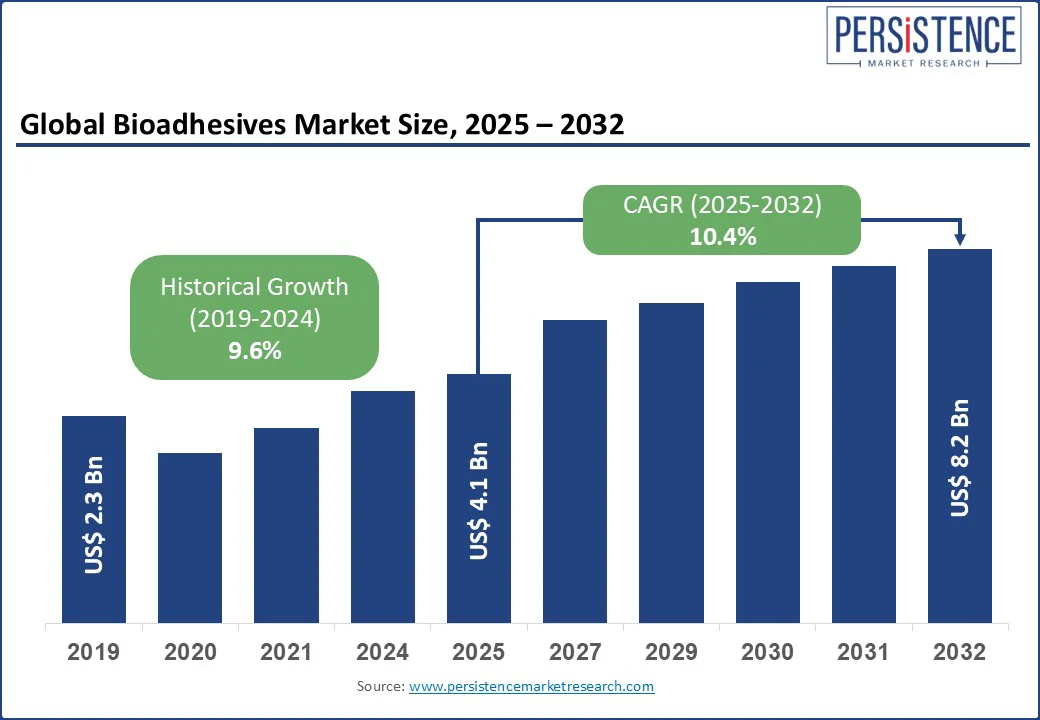ID: PMRREP3670| 186 Pages | 4 Aug 2025 | Format: PDF, Excel, PPT* | Chemicals and Materials

The global bioadhesives market size is expected to reach US$ 4.1 bn in 2025 and is expected to reach US$ 8.2 bn by 2032, growing at a CAGR of 10.4% during the forecast period 2025 - 2032. The growth is fueled by increasing demand for sustainable and eco-friendly alternatives to synthetic adhesives.
The global Bioadhesives, derived from renewable adhesives sourced from plants and animals, are gaining traction due to their eco-friendly adhesive properties, including biodegradability and lower carbon footprints compared to synthetic adhesives. The bioadhesives market size and forecast indicate steady growth driven by rising environmental consciousness, stringent regulations on chemical-based adhesives, and advancements in bio-based technologies. The market's growth is further supported by innovations in organic adhesive formulations, making them viable alternatives to conventional adhesives in high-performance applications.

The bioadhesives market is witnessing robust growth, primarily driven by stringent environmental regulations and rising sustainability goals. Governments across the globe are enforcing measures to minimize volatile organic compound (VOC) emissions and support the shift toward renewable and biodegradable materials. For instance, the European Union’s REACH regulations mandate the reduction of hazardous substances in adhesives, while the U.S. Environmental Protection Agency (EPA) promotes the use of greener alternatives. As a result, manufacturers in regions like Europe are increasingly adopting bio-based adhesives made from natural sources such as starch, soy protein, and lignin to comply with evolving eco-friendly standards.
The global packaging industry is shifting toward sustainability, largely driven by rising consumer awareness. Manufacturers are increasingly adopting eco-friendly adhesives, such as starch-based or plant-derived glues, in response to demand for greener packaging solutions. For instance, companies producing corrugated boxes or paper-based mailers are opting for natural adhesives to reduce their environmental footprint. Moreover, the rapid growth of e-commerce is intensifying the need for sustainable, durable adhesives suitable for shipping and logistics. This trend is accelerating innovation in the packaging materials sector.
Biobased adhesives, especially those made from advanced plant-based sources such as lignin, face cost-related challenges despite their environmental benefits. Extracting and processing lignin involves complex purification techniques, which significantly raise production costs. For instance, manufacturing lignin-based adhesives often requires multi-step chemical treatments to isolate and modify the lignin for effective bonding performance. As a result, these adhesives can be 20-30% more expensive than traditional synthetic alternatives such as polyurethane or epoxy resins. This cost disparity makes large-scale adoption difficult for some manufacturers, particularly in price-sensitive markets, despite increasing pressure to transition to sustainable and eco-friendly adhesive solutions.
The expansion of emerging markets is creating significant growth opportunities for eco-friendly adhesives, particularly in regions such as Asia Pacific and Latin America. Rapid industrialization, urban development, and infrastructure investments are driving demand for sustainable materials in construction and packaging. For instance, India’s construction sector is increasingly adopting renewable adhesives in green building projects and sustainable infrastructure. Similarly, countries such as Brazil and Indonesia are witnessing a surge in eco-conscious packaging practices due to regulatory support and consumer demand. These trends are encouraging manufacturers to innovate and invest in bio-based adhesives tailored to the needs of emerging economies.
The development of hybrid bioadhesives blending biobased materials with synthetic components is gaining traction as a strategy to enhance adhesive performance while maintaining sustainability. This approach improves key properties such as moisture resistance, durability, and bonding strength, making these adhesives suitable for a wider range of industrial applications. For instance, hybrid adhesives combining lignin or starch with synthetic resins are being used in sustainable wood composites and packaging materials, where pure bioadhesives may fall short. Industry analysts project that this innovation could boost especially in the construction, automotive, and packaging sectors.
United States:
The global bioadhesives market is highly competitive, driven by innovation, sustainability goals, and strategic collaborations. Leading companies such as Henkel and Arkema are investing significantly in R&D to develop high-performance, bio-based adhesives, with Henkel dedicating around 5% of its annual revenue toward sustainable adhesive research. Partnerships are central to market expansion, as seen with Ingredion collaborating with e-commerce and packaging firms to meet the rising demand for eco-friendly adhesive solutions. Meanwhile, companies like EcoSynthetix and Danimer Scientific are focusing on organic formulations, aligning their portfolios with global sustainability mandates. This strategic emphasis on R&D, end-user alliances, and renewable product development is shaping the competitive landscape of the bioadhesives industry.
The bioadhesives market size is projected to reach US$ 4.1 billion in 2025.
Rising demand for eco-friendly adhesives, stringent environmental regulations, and advancements in biobased adhesives technologies are key drivers.
The bioadhesives market is poised to witness a CAGR of 10.4% from 2025 to 2032.
Expansion in emerging markets, development of hybrid natural adhesives, and growing demand for biocompatible adhesives in applications of bioadhesives in healthcare are key opportunities.
Henkel AG, Ingredion, LD Davis, Danimer Scientific, Arkema SA, EcoSynthetix Inc., Ashland Inc., DuPont, The Compound Company, and CryoLife Inc. are key players.
|
Report Attribute |
Details |
|
Historical Data/Actuals |
2019 - 2024 |
|
Forecast Period |
2025 - 2032 |
|
Units |
Value: US$ bn |
|
2025 (E) |
US$ 4.1 bn |
|
2032 (F) |
US$ 8.2 bn |
|
Historical CAGR (2019 - 2024) |
9.6% |
|
Projected CAGR (2025 - 2032) |
10.4% |
|
Geographical Coverage |
|
|
Segment Coverage |
|
|
Competitive Analysis |
|
|
Report Highlights |
|
|
Customization and Pricing |
Available upon Request |
By source Type
By Application
By Technology
By Region
Delivery Timelines
For more information on this report and its delivery timelines please get in touch with our sales team.
About Author